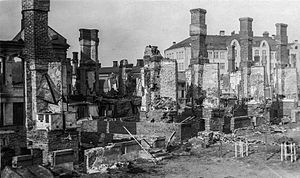Finland's population grew rapidly in the nineteenth century (from 860,000 in 1810 to 3,130,000 in 1917) and a class of agrarian and industrial workers, as well as peasants emerged over the period. The Industrial Revolution was rapid in Finland, though it started later than in the rest of Western Europe.
Industrialisation was financed by the state and some of the social problems associated with the industrial process were diminished by the administration's actions. Among urban workers, socio-economic problems steepened during periods of industrial depression. The position of rural workers worsened after the end of the nineteenth century, as farming became more efficient and market-oriented and the development of industry was not vigorous enough to fully utilise the rapid population growth of the countryside.
Various rifles used in the Finnish civil war with bayonets in Mikkeli Infantry museum.. From the top:
1.) Russian 7.62 mm Mosin-Nagant m/91
2.) Japanese 6.5 mm Type 38 (Arisaka m/1905)
3.) German 7.92 mm Mauser m/1898
4.) American 7.62 mm Winchester m/1895
Revolutionary Russian servicemen of various political groups added to the feeling of the instability during 1917.
Some 400 Swedes fought with the White forces during the Finnish Civil War
(so called "Swedish Brigade").
The Swedish Army also invaded Åland Islands during the war.
Jaeger Battalion
The difference between Scandinavian-Finnish (Finno-Ugric peoples) and Russian-Slavic culture affected the nature of Finnish national integration. The upper social strata took the lead and gained domestic authority from the Russian czar in 1809.
The estates planned to build up an increasingly autonomous Finnish state, led by the elite and the intelligentsia. The Fennoman movement aimed to include the common people in a non-political role; the labour movement, youth associations and the temperance movement were initially led "from above".
Between 1870 and 1916 industrialisation gradually improved social conditions and the self-confidence of workers, but while the standard of living of the common people rose in absolute terms, the rift between rich and poor deepened markedly.
The commoners' rising awareness of socio-economic and political questions interacted with the ideas of socialism, social liberalism and nationalism.
The workers' initiatives and the corresponding responses of the dominant authorities intensified social conflict in Finland
The territory of the Kingdom of Poland was not mentioned in the treaty, because Russian Poland had been a personal possession of the Tsar, not part of the Empire.
The Russians only hopes were that given time their allies would agree to join the negotiations or that the western European proletariat would revolt, so their best strategy was to prolong the negotiations. As Foreign Minister Leon Trotsky wrote "To delay negotiations, there must be someone to do the delaying". Therefore Trotsky replaced Joffe as the leader.
Relations between Russia and the victors did not go smoothly. The Ottoman Empire broke the treaty by invading the newly created First Republic of Armenia in May 1918. Joffe became the Russian ambassador to Germany. His priority was distributing propaganda to trigger the German revolution. On 4 November 1918 "the Soviet courier's packing-case had 'come to pieces'" in a Berlin railway station; it was filled with insurrectionary documents. Joffe and his staff were ejected from Germany in a sealed train on 5 November 1918.
In the Armistice of 11 November 1918 that ended World War I, one clause abrogated the Brest-Litovsk treaty. Next the Bolshevik legislature (VTsIK) annulled the treaty on 13 November 1918, and the text of the VTsIK Decision was printed in Pravda newspaper the next day. In the year after the armistice following a timetable set by the victors the German Army withdrew its occupying forces from the lands gained in Brest-Litovsk. The fate of the region, and the location of the eventual western border of the Soviet Union, was settled in violent and chaotic struggles over the course of the next three and a half years. The Polish–Soviet War was particularly bitter; it ended with the Treaty of Riga in 1921.
Although most of Ukraine fell under Bolshevik control and eventually became one of the constituent republics of the Soviet Union, Poland and the Baltic states emerged as independent countries.
In the Treaty of Rapallo, concluded in April 1922, Germany accepted the Treaty's nullification, and the two powers agreed to abandon all war-related territorial and financial claims against each other. This state of affairs lasted until 1939.
As a consequence of the Molotov-Ribbentrop Pact, the Soviet Union advanced its borders westward by invading Poland in September 1939 and taking a small part of Finland in November 1939 and annexing the Baltic States, Eastern Poland and Bessarabia in 1940.
It thus overturned almost all the territorial losses incurred at Brest-Litovsk, except for the main part of Finland, western Congress Poland, and western Armenia.






Ei kommentteja:
Lähetä kommentti
Any explosive ammunition or empty cores, you can put in this.